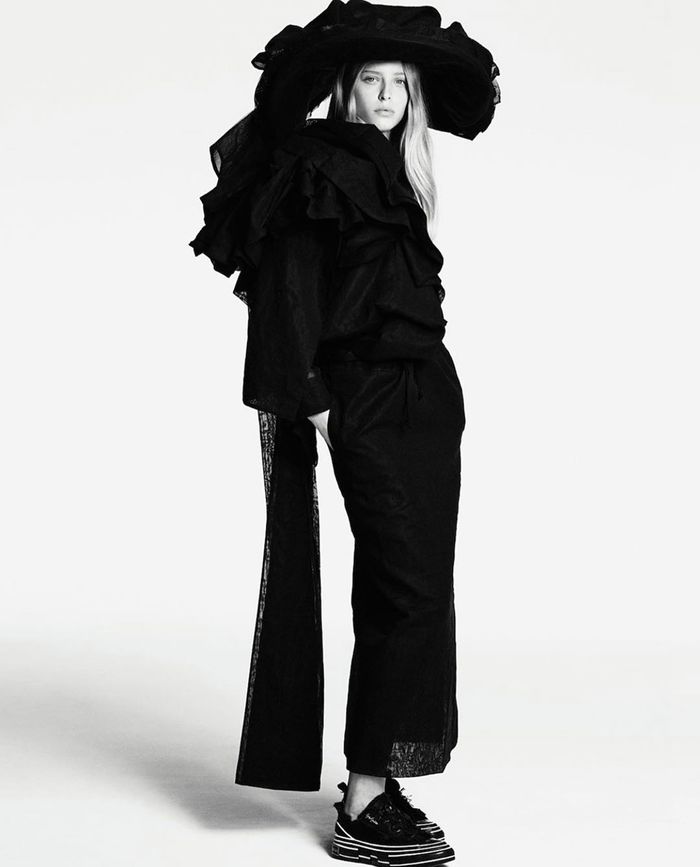Versace VS Armani: Mistress and the Wife?
Fashion columnist Eva Morris interrogates how Anna Wintour’s famous assertion ‘Versace dresses the mistress, Armani dresses the wife’ is deeply rooted in historically enshrined misogynistic tropes

A tale as old as time: man and wife have been together for twenty odd years. She was his childhood sweetheart and has dinner on the table for 6pm every night. At some point the man is depicted as restless, searching for excitement in a femme fatale and bringing the elusive mistress onto the scene. The roles of mistress and wife have been used for story-telling and to sideline wives while demonising youthful women for centuries. Such a patriarchal tradition is reflected in the fashionable phrase, ‘Versace dresses the mistress while Armani dresses the wife’ incanted by many fashion-lovers. A seemingly harmless phrase, it is steeped in sinister stereotypes and shallow judgements.

The word ‘Versace’ instantly evokes his classic AW 1992 “Bondage” collection where he played with ideas of fetish-wear with leather, harnesses and dog collars. Versace has always revolved around the world of sex appeal associated with feminine youth. Another emblem of the brand is Oreton; the signature chain-mail that drapes like silk over the figure. The material has become an icon of Versace, bringing forth images of youthful Greek Goddesses when worn on the runway. It’s clear that Versace revels in all things youthful and sexy. When Armani comes to mind, however, there is no specific collection but an eternal attitude of elegance spanning decades. From Michelle Pfeiffer’s iconic fitted suit at the 1989 Academy Awards, to Katie Holmes and Tom Cruise dripping in Armani at their wedding in Odescalchi Castle in Italy: Armani is timeless and doesn’t chase after momentary fan-fare, the epitome of the elegant woman. These may just be tropes frivolously played with in the odd chick-flick or magazine, but if we look at the context of such tropes and the role they play in society through the clothes we wear, both ideals may have potent influence.
Gianni Versace was influenced by Ancient Greek history prominent in his birth town Reggio Calabria. Ancient Greek literature abounds with misogynistic stories of troublesome women. From Aphrodite being accused of using her charms to manipulate men into irrationality, to Hera’s portrayed overemotional jealousy over Zeus’ infidelity, stories of women as creatures of wild emotion toying with man’s rationality have left their mark. For Versace to take such inspiration from such myths, with a target audience of predominantly young women, holds significance in the type-casting of young women as the seductive enemy.

Armani founded his company in 1975 with a very different vision. Armani told Women’s Wear Daily “I believed in getting rid of the artifice of clothing. I believed in neutral colours”. This reference to resisting clothing’s use as a device of trickery, and the subversion of this into something more honest is starkly different to Versace’s brand. The subdued avoidance of bright colour in favour of neutrals feels reminiscent of ’The Great Masculine Renunciation’ at the end of the 18th century. Menswear gradually blocked out all bright colours and ‘abandoned their claim to be considered beautiful’ to be solely useful. When we see Armani emphasising neutrals, it is a step away from Versace’s feminine aesthetics and an attempt to focus on the female wearer as practical and useful, as opposed to deceitful and frivolous. Once again the male gaze dominates the creation of ‘perfect woman’ in Armani: someone with the tamed beauty of a woman but the attitudes of a man.

This cultural phenomenon of women appearing naturally beautiful yet acting in masculine ways to appeal to a male fantasy is normally only analysed in the media. To see it so blatantly in the clothes we wear and aspire to epitomised by the phrase ‘Armani dresses the wife’ shows how blatantly these ideals of the male gaze have seeped into every facet of the industry.
If we turn to look at the way each fashion house is organised we see more contrast. Armani has expanded as a business to restaurants and hotels, seldom making creative leaps in its design but always selling. Versace’s creative direction is far more daring, valuing artistic endeavour as highly as pragmatic business. Armani is far more digestible in the stereotypically male world of business, while Versace finds itself excelling at ‘feminine’ artistic direction. The varying attitudes to masculinity and femininity in the structure of the fashion houses speaks multitudes as to how the two concepts are presented within society.
‘Versace dresses the mistress while Armani dresses the wife’ is not just a throwaway phrase about the different styles each house embodies but holds cultural roots in male fantasies of feminine ideals. The way we sell the clothes we wear speaks volumes. Hyper feminine styles are deemed inappropriate yet alluringly attention grabbing, while masculine neutral tones in ‘classic’ shapes are deemed the epitome of class. I don’t know about you, but I’d rather be a Versace woman.
 News / Under 3% of applicants for Cambridge academic jobs are successful7 April 2025
News / Under 3% of applicants for Cambridge academic jobs are successful7 April 2025 Features / Cambridge: where toxic productivity turns rest into a radical act8 April 2025
Features / Cambridge: where toxic productivity turns rest into a radical act8 April 2025 News / News in Brief: cats, Camelot, and construction woes6 April 2025
News / News in Brief: cats, Camelot, and construction woes6 April 2025 Comment / Cambridge’s gossip culture is a double-edged sword7 April 2025
Comment / Cambridge’s gossip culture is a double-edged sword7 April 2025 Sport / Previewing the 170th Boat Race7 April 2025
Sport / Previewing the 170th Boat Race7 April 2025





